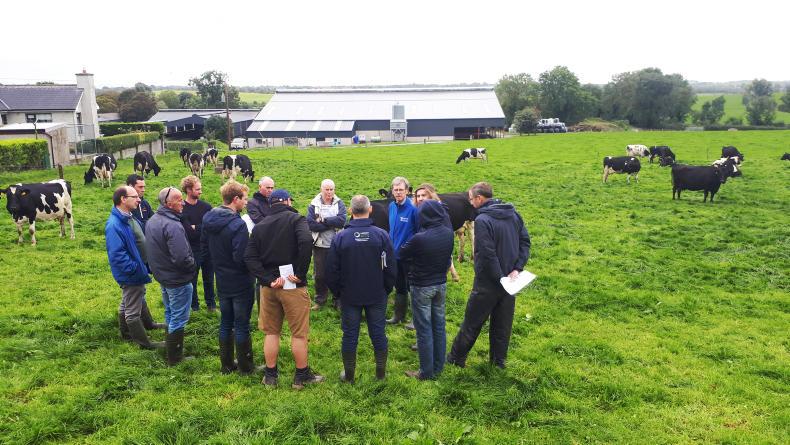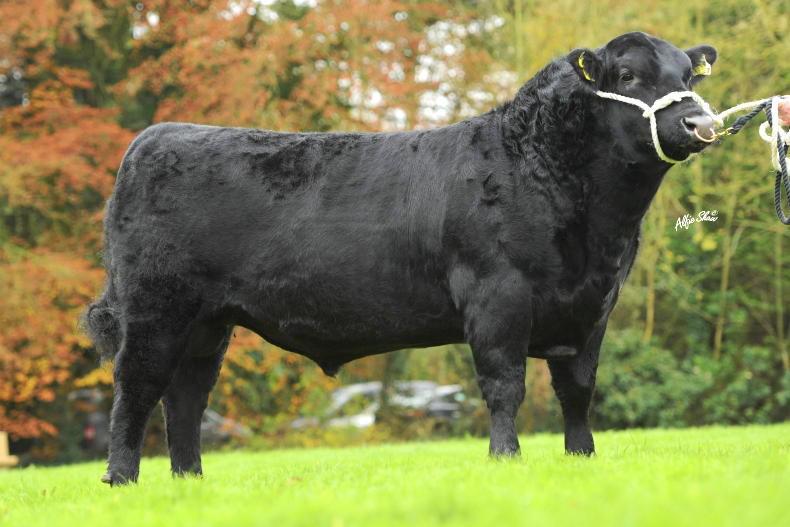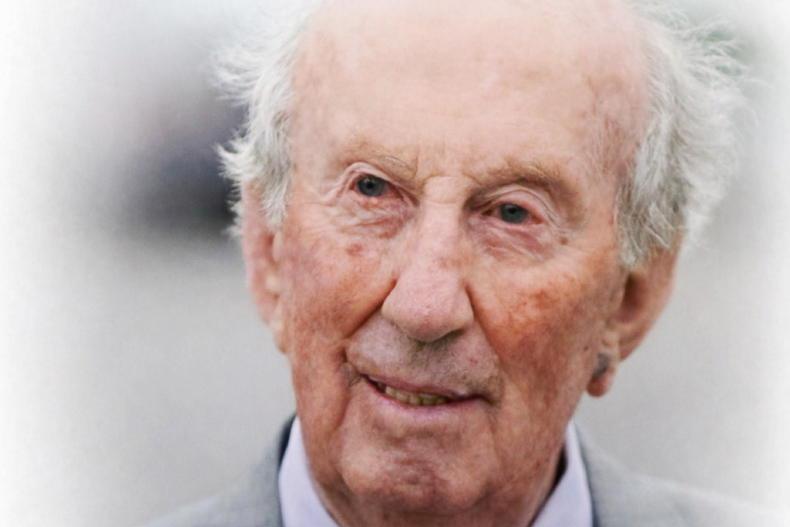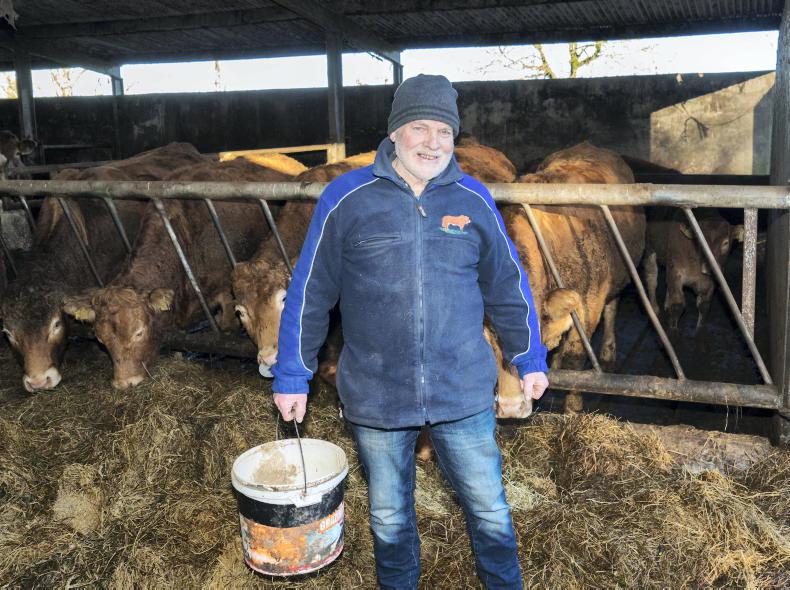Niall Matthews is farming on the Monaghan/Louth border milking 220 cows for Lakeland Dairies. In 2009, Niall had 80 spring-calving cows producing 6,000 litres at 3.3% protein and 3.8% fat (438kg MS/cow).
This was coming from a diet of mainly grazed grass and feeding over 1t of meal per cow. Fertility was poor, with over 20% not in-calf each year.
Ten years later in 2019, Niall says he’s on track to deliver as much milk volume per cow, over 6,000 litres per cow, but the fat percentage is now 4.4% and protein is now 3.62% (559kg MS/cow on his ICBF Co-op performance sheet for 2018).
Fundamentally, Niall puts a large part of this increase in milk quality down to better breeding decisions. He has been selecting high-fertility black and white sires and also sires that will improve milk solids for over 10 years.
Niall said: “It’s the easiest money you’ll ever make out of milk. I’m doing the very same as I was doing in 2009 – trying to do the grass right, trying to manage the cows properly, feeding about the same level of meal, but because the milk solids quality is better, I’m getting a lot more for my product.
“Fertility is probably not as good as I would like, but it’s much improved. This year, scanning suggests we’ll have 12% to 13% of cows not in calf.”
In-calf rate
While the rate of those not in-calf may be slightly higher than Niall would like, Teagasc specialist Joe Patton is quick to point out other herd fertility measures are still quite good – calving interval for 2018 was 370 days, six-week calving rate was 83% and 58 out of the 61 in-calf heifers calved down between 22 and 26 months of age.
Herd EBI is €145, which effectively puts it in the top 10% of herds in the Lakeland catchment region and well up there on a national scale.
Last week, Dairylink farmers from Northern Ireland gathered on Niall’s farm to hear his reasoning behind breeding decisions.
Niall said: “Look, I have no set desire for show cows or particular family lines or particular sires. For the last 10 years, I’ve been picking the best available sires on the EBI active bull list and I’ve been selecting within that for fertility and better milk solids.”
The Dairylink farmers at the walk wrote up their annual performance on the white board at the farm walk. Essentially, it showed that, on average as a group, they were delivering around the same milk solids per cow as Niall, but the Dairylink farmers were feeding about 2t more meal per cow.
Average volume per cow was about 2,000 litres higher than Niall’s output and percentages were lower. So when you boil it all down, basically in 2018 Niall’s herd was doing the Dairylink group average production in terms of milk solids per cow (circa 560kg MS/cow), but with a lot less reliance on purchased feed, less volume per cow and higher fat and protein percentages.
Impact
The group quizzed him on how long it took to see impact of the breeding decisions in the tank.
He said: “At the start, when fertility is poor, it’s hard to make progress as you are losing that many cows per year. It took at least three or four years and often I was disillusioned in the early days, but I persevered and that’s what you have to do – it takes time.”
We all know breeding is long term and it can be hard to stick with a plan when you don’t see immediate differences in the tank.
Niall said: “I’ll be honest, I was expecting to see milk solids grow more and faster, but it took us four to five years to see the difference in the tank. We actually went back a bit in terms of volume for a while, but as the herd matures and cows stay around longer, the yield goes up.
“The perception of EBI among some farmers is that if selecting high-EBI sires you will start losing volume. For some individual cows, we did see this, but as a herd average you gain.”
Niall was very clear on the benefits of EBI breeding on his herd: “If I was selling the milk today at the same solids as I was in 2009, our milk cheque would be €65,000 less.
“I would say it’s mostly down to breeding, because if you don’t have the genetics you can stand on your head and feed what you like, but you won’t get the same milk solids.”
The 6,800 litres per cow delivered in 2018 was from grazed grass and about 1.4t of meal per cow.
The herd was milked once a day from the end of November to drying off and again milked once a day from 1 February to 1 March.
When questioned if grassland management had changed to benefit the better results, Niall said it probably had a little bit but not that much.
“Maybe we are getting out to grass a week earlier, staying out a few days later in the autumn and maybe we have been making slightly better silage, but I reckon the impact is minimal.
Decision time for AI sires for autumn herds is getting closer and closer.
Ideally, dairy farmers who start autumn breeding in November and December should use October to gather the information they need to make informed decisions. It’s the best time you can invest that will deliver for you five years down the line.
Selecting sires for better fertility and better milk solids has delivered for Niall Matthews.
Read more
Dairylink: third cut under plastic on the border
Calf rearing lessons from the Netherlands
Niall Matthews is farming on the Monaghan/Louth border milking 220 cows for Lakeland Dairies. In 2009, Niall had 80 spring-calving cows producing 6,000 litres at 3.3% protein and 3.8% fat (438kg MS/cow).
This was coming from a diet of mainly grazed grass and feeding over 1t of meal per cow. Fertility was poor, with over 20% not in-calf each year.
Ten years later in 2019, Niall says he’s on track to deliver as much milk volume per cow, over 6,000 litres per cow, but the fat percentage is now 4.4% and protein is now 3.62% (559kg MS/cow on his ICBF Co-op performance sheet for 2018).
Fundamentally, Niall puts a large part of this increase in milk quality down to better breeding decisions. He has been selecting high-fertility black and white sires and also sires that will improve milk solids for over 10 years.
Niall said: “It’s the easiest money you’ll ever make out of milk. I’m doing the very same as I was doing in 2009 – trying to do the grass right, trying to manage the cows properly, feeding about the same level of meal, but because the milk solids quality is better, I’m getting a lot more for my product.
“Fertility is probably not as good as I would like, but it’s much improved. This year, scanning suggests we’ll have 12% to 13% of cows not in calf.”
In-calf rate
While the rate of those not in-calf may be slightly higher than Niall would like, Teagasc specialist Joe Patton is quick to point out other herd fertility measures are still quite good – calving interval for 2018 was 370 days, six-week calving rate was 83% and 58 out of the 61 in-calf heifers calved down between 22 and 26 months of age.
Herd EBI is €145, which effectively puts it in the top 10% of herds in the Lakeland catchment region and well up there on a national scale.
Last week, Dairylink farmers from Northern Ireland gathered on Niall’s farm to hear his reasoning behind breeding decisions.
Niall said: “Look, I have no set desire for show cows or particular family lines or particular sires. For the last 10 years, I’ve been picking the best available sires on the EBI active bull list and I’ve been selecting within that for fertility and better milk solids.”
The Dairylink farmers at the walk wrote up their annual performance on the white board at the farm walk. Essentially, it showed that, on average as a group, they were delivering around the same milk solids per cow as Niall, but the Dairylink farmers were feeding about 2t more meal per cow.
Average volume per cow was about 2,000 litres higher than Niall’s output and percentages were lower. So when you boil it all down, basically in 2018 Niall’s herd was doing the Dairylink group average production in terms of milk solids per cow (circa 560kg MS/cow), but with a lot less reliance on purchased feed, less volume per cow and higher fat and protein percentages.
Impact
The group quizzed him on how long it took to see impact of the breeding decisions in the tank.
He said: “At the start, when fertility is poor, it’s hard to make progress as you are losing that many cows per year. It took at least three or four years and often I was disillusioned in the early days, but I persevered and that’s what you have to do – it takes time.”
We all know breeding is long term and it can be hard to stick with a plan when you don’t see immediate differences in the tank.
Niall said: “I’ll be honest, I was expecting to see milk solids grow more and faster, but it took us four to five years to see the difference in the tank. We actually went back a bit in terms of volume for a while, but as the herd matures and cows stay around longer, the yield goes up.
“The perception of EBI among some farmers is that if selecting high-EBI sires you will start losing volume. For some individual cows, we did see this, but as a herd average you gain.”
Niall was very clear on the benefits of EBI breeding on his herd: “If I was selling the milk today at the same solids as I was in 2009, our milk cheque would be €65,000 less.
“I would say it’s mostly down to breeding, because if you don’t have the genetics you can stand on your head and feed what you like, but you won’t get the same milk solids.”
The 6,800 litres per cow delivered in 2018 was from grazed grass and about 1.4t of meal per cow.
The herd was milked once a day from the end of November to drying off and again milked once a day from 1 February to 1 March.
When questioned if grassland management had changed to benefit the better results, Niall said it probably had a little bit but not that much.
“Maybe we are getting out to grass a week earlier, staying out a few days later in the autumn and maybe we have been making slightly better silage, but I reckon the impact is minimal.
Decision time for AI sires for autumn herds is getting closer and closer.
Ideally, dairy farmers who start autumn breeding in November and December should use October to gather the information they need to make informed decisions. It’s the best time you can invest that will deliver for you five years down the line.
Selecting sires for better fertility and better milk solids has delivered for Niall Matthews.
Read more
Dairylink: third cut under plastic on the border
Calf rearing lessons from the Netherlands









SHARING OPTIONS